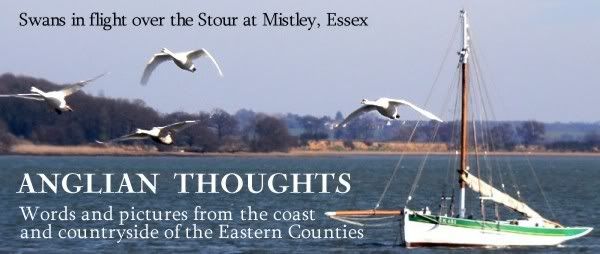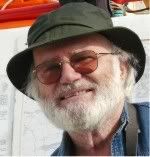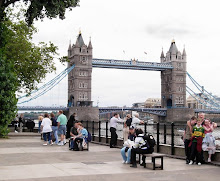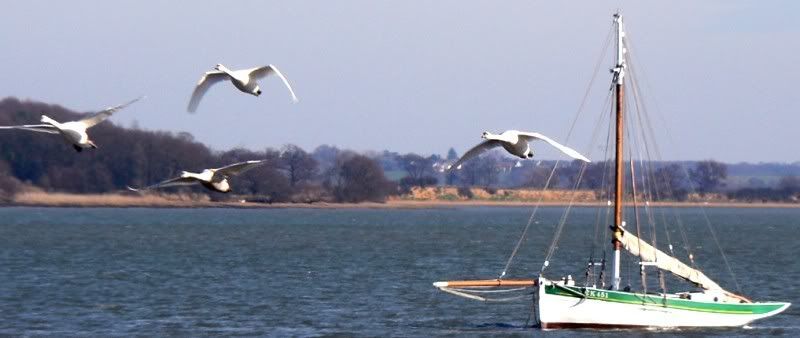I note with sadness that the website I created for Felixstowe Museum in 2007 and updated regularly with information about new displays and events, appears to have been abandoned since I resigned on August 1 due to failing health and the cost of the weekly drive to Felixstowe, in spite of my efforts to effect a smooth transition to a new webmaster.
I send my apologies to the 20 or so tourism and information websites who kindly allowed links on their own sites, which now contain inaccurate information and announcements of 'forthcoming' events which finished several months ago. The volunteers who keep the museum ruinning deserve better than this!
I regret that I am no longer able to access the site to repair the damage, and sincerely hope that whoever now has the password will find someone to help with an urgent update before the new season commences.
Tuesday, December 9, 2008
Thursday, October 9, 2008
Friday, November 16, 2007
A walk in Dedham Vale
A few pictures taken on a walk through Constable
country last week -- a small diversion on my way
home from Frinton.

Willy Lott's Cottage at Flatford

The Granary, Flatford.

Fungus beneath a hedge beside Flatford Mill.

Flatford Bridge

River Stour between Flatford & Dedham


Another footbridge half-way along my walk

Cattle in the Vale
country last week -- a small diversion on my way
home from Frinton.

Willy Lott's Cottage at Flatford

The Granary, Flatford.

Fungus beneath a hedge beside Flatford Mill.

Flatford Bridge

River Stour between Flatford & Dedham


Another footbridge half-way along my walk

Cattle in the Vale
Saturday, November 10, 2007
The flood that never was
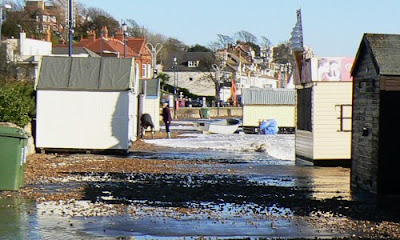

Hundreds of families on the East coast were evacuated on the night of November 8/9, 2007, when the highest tides for more tnan half a century and widespread flooding were forecast.
Fortunately the worst predictions did not come true but I got a few pictures (and wet feet) on Felixstowe sea front next morning.
There was minor damage to some beach huts (as there is every year) and some spectacular waves breaking over the promenade, and ships anchored offshore waiting for the Port to reopen, but the disaster scenario happily did not develop. I say 'happily' speaking as a human being, but the old newspaper mind was perhaps just a little disappointed that there was so little to photograph after all that was promised.

Wednesday, October 31, 2007
An Essex town that time forgot
“When the end of the world comes, I hope to be in Frinton, which will still be twenty years behind the times.”
Those words come from a local residents’ newsletter in what might well be described as the most boring seaside town in England. I have just returned from a refreshing weekend there and am not complaining about the lack of facilities because that is the charm of Frinton-on-Sea, a small cliff-top town on the Essex coast overlooking the North Sea, which tries hard to pretend that it is still in the Edwardian era.
Unlike so many other coastal resorts, Frinton is not a place to visit for ‘seaside fun’ such as amusement arcades or dodg’em cars, and there is no chance of a concert on the pier, because there isn’t one! Nor are there any ice-cream kiosks or hot dog stands on the promenade or anywhere else in the town, or deck chairs for hire on the beach.
There is however one pub, which got its licence only five years ago when the local council overturned an ancient city ordinance prohibiting such establishments and allowed a Kent brewery (Essex breweries presumably wouldn’t dare to ask!) to open ‘The Lock and Barrel’ as a pub-restaurant in a former locksmith’s premises on the single shopping street, which genteel Frinton calls an avenue . . . so much nicer than ‘street‘, don’t you think?
The town developed in the late 1800s with the coming of the railway and the line became popular in the days before car ownership carrying holiday-makers and day trippers in their thousands to nearby Clacton, which today is a noisy bustling town with amusement arcades in its main shopping streets near the sea-front and a pier which makes a massive contribution to global warming with its blazing lights and over-amplified music pumped out from high-powered loudspeakers masking the sound of £1 coins being pushed at a frantic rate into seemingly endless rows of slot machines.
Frinton has always appealed to a different clientele: in the 1920s and 1930s liveried waiters from the Grand Hotel could be seen carrying tea and cakes on silver trays, across the wide green sward and down the cliffside steps to their customers enjoying the sea air from their beach huts on the promenade. The beach huts are still there but their erstwhile guests, said to have included such latter-day celebrities as famous actors and artists of the day, are not. It is known that a number of works by Picasso were found when clearing the home of a former resident, reputed to have been a friend of the artist, who may have stayed and even worked there, and there was also small sculpture by another friend, Rodin which fetched a considerable sum at auction.
It seems that the residents and city fathers have never courted publicity but valued their isolation, protected from outsiders on one side by the sea and on the other by the railway which is still served by a manned level crossing, seen by today’s residents see as their last line of defence. The words ‘inside the gates‘ are in everyday use to describe the original Frinton, to differentiate it from the sprawling modern housing estate which has sprung up on the other side of the track.
A paragraph in the residents’ newsletter mentions without enthusiasm a mooted plan to replace the gates with an automatic barrier, and this raises memories of the resolute British determination inspired by Winston Churchill’s wartime words, “We will fight them on the beaches”, when every man, woman and child was prepared to take up arms to defend their homeland and way of life from the anticipated invasion. A visitor might be forgiven for asking whether the wartime pill-box, built over 60 years ago and still occupying a commanding position with gun slots facing the level crossing, might yet be called into action.
Those words come from a local residents’ newsletter in what might well be described as the most boring seaside town in England. I have just returned from a refreshing weekend there and am not complaining about the lack of facilities because that is the charm of Frinton-on-Sea, a small cliff-top town on the Essex coast overlooking the North Sea, which tries hard to pretend that it is still in the Edwardian era.
Unlike so many other coastal resorts, Frinton is not a place to visit for ‘seaside fun’ such as amusement arcades or dodg’em cars, and there is no chance of a concert on the pier, because there isn’t one! Nor are there any ice-cream kiosks or hot dog stands on the promenade or anywhere else in the town, or deck chairs for hire on the beach.
There is however one pub, which got its licence only five years ago when the local council overturned an ancient city ordinance prohibiting such establishments and allowed a Kent brewery (Essex breweries presumably wouldn’t dare to ask!) to open ‘The Lock and Barrel’ as a pub-restaurant in a former locksmith’s premises on the single shopping street, which genteel Frinton calls an avenue . . . so much nicer than ‘street‘, don’t you think?
The town developed in the late 1800s with the coming of the railway and the line became popular in the days before car ownership carrying holiday-makers and day trippers in their thousands to nearby Clacton, which today is a noisy bustling town with amusement arcades in its main shopping streets near the sea-front and a pier which makes a massive contribution to global warming with its blazing lights and over-amplified music pumped out from high-powered loudspeakers masking the sound of £1 coins being pushed at a frantic rate into seemingly endless rows of slot machines.
Frinton has always appealed to a different clientele: in the 1920s and 1930s liveried waiters from the Grand Hotel could be seen carrying tea and cakes on silver trays, across the wide green sward and down the cliffside steps to their customers enjoying the sea air from their beach huts on the promenade. The beach huts are still there but their erstwhile guests, said to have included such latter-day celebrities as famous actors and artists of the day, are not. It is known that a number of works by Picasso were found when clearing the home of a former resident, reputed to have been a friend of the artist, who may have stayed and even worked there, and there was also small sculpture by another friend, Rodin which fetched a considerable sum at auction.
It seems that the residents and city fathers have never courted publicity but valued their isolation, protected from outsiders on one side by the sea and on the other by the railway which is still served by a manned level crossing, seen by today’s residents see as their last line of defence. The words ‘inside the gates‘ are in everyday use to describe the original Frinton, to differentiate it from the sprawling modern housing estate which has sprung up on the other side of the track.
A paragraph in the residents’ newsletter mentions without enthusiasm a mooted plan to replace the gates with an automatic barrier, and this raises memories of the resolute British determination inspired by Winston Churchill’s wartime words, “We will fight them on the beaches”, when every man, woman and child was prepared to take up arms to defend their homeland and way of life from the anticipated invasion. A visitor might be forgiven for asking whether the wartime pill-box, built over 60 years ago and still occupying a commanding position with gun slots facing the level crossing, might yet be called into action.
Thursday, October 25, 2007
A Suffolk Childhood
Peter Banyard's life and times:

I am indebted to Mr Peter Banyard, ex-RAF aircrew and Suffolk policeman, for permission to reproduce these snapshots from his childhood in Woodbridge, Suffolk. The first picture shows a group of dignitaries at the opening of a model boating pool and the second was a tree planting cereony. Both events took place in 1935 to mark the Silver Jubilee of King George V and Queen Mary.
The picture at the lower left shows Peter with his grandfather, and lower right is a typical mixed business and leisure scene on the Deben when the river was a busy navigable waterway. Two sailing barges can be seen in the left background with the edge of the Tide Mill just visible behind them. The barges were a common sight on the river, carrying bulk coal and corn. Other pictures on this page are of his grandfather's boat, Phoenix.
Peter also has many tales to tell of fishing and mudlarking in his youth. A length of iron rod, sharpened at one end, made a good fishing spear and hewould paddle out in the mud at low tide and get a good catch of dabs - and sometimes a good hiding if he got home covered in mud!" Eels were plentiful too, and he would go with his friends, first to catch lug-worms as bait and would take their catch of eels to The Boat Inn on the quayside, where the landlady would either buy them or persuade her customers to contribute some pennies to the boys so that they could buy fish and chips for supper. "Fish and chips cost 4d (four pre-decimal pence)and there were usually four of us, so we needed to collect 16 pence," he recalls. "The old woman, Mrs Borrett her name was, was a real Romany. She lived in the pub - it was a 'spit and sawdust' kind of place - and had her caravan parked out in the yard."

The Boat Inn is now a private dwelling but traces of the name can still be seen under the pink paint and the new owners now use it as a house name on a sign over the front door.
At the outbreak of World War 2, Peter joined the RAF straight from school and served as a bomb-aimer in Lancasters flying from Suffolk bases. After the war he swapped his RAF uniform for that of the Suffolk Constabulary.
This article first appeared in Wordsweb Magazine in 2005. If anyone else has any snapshots or memories they would like to share, please email me or post to Wordsweb Forum

I am indebted to Mr Peter Banyard, ex-RAF aircrew and Suffolk policeman, for permission to reproduce these snapshots from his childhood in Woodbridge, Suffolk. The first picture shows a group of dignitaries at the opening of a model boating pool and the second was a tree planting cereony. Both events took place in 1935 to mark the Silver Jubilee of King George V and Queen Mary.
The picture at the lower left shows Peter with his grandfather, and lower right is a typical mixed business and leisure scene on the Deben when the river was a busy navigable waterway. Two sailing barges can be seen in the left background with the edge of the Tide Mill just visible behind them. The barges were a common sight on the river, carrying bulk coal and corn. Other pictures on this page are of his grandfather's boat, Phoenix.
Peter also has many tales to tell of fishing and mudlarking in his youth. A length of iron rod, sharpened at one end, made a good fishing spear and hewould paddle out in the mud at low tide and get a good catch of dabs - and sometimes a good hiding if he got home covered in mud!" Eels were plentiful too, and he would go with his friends, first to catch lug-worms as bait and would take their catch of eels to The Boat Inn on the quayside, where the landlady would either buy them or persuade her customers to contribute some pennies to the boys so that they could buy fish and chips for supper. "Fish and chips cost 4d (four pre-decimal pence)and there were usually four of us, so we needed to collect 16 pence," he recalls. "The old woman, Mrs Borrett her name was, was a real Romany. She lived in the pub - it was a 'spit and sawdust' kind of place - and had her caravan parked out in the yard."

The Boat Inn is now a private dwelling but traces of the name can still be seen under the pink paint and the new owners now use it as a house name on a sign over the front door.
At the outbreak of World War 2, Peter joined the RAF straight from school and served as a bomb-aimer in Lancasters flying from Suffolk bases. After the war he swapped his RAF uniform for that of the Suffolk Constabulary.
This article first appeared in Wordsweb Magazine in 2005. If anyone else has any snapshots or memories they would like to share, please email me or post to Wordsweb Forum
Subscribe to:
Comments (Atom)
